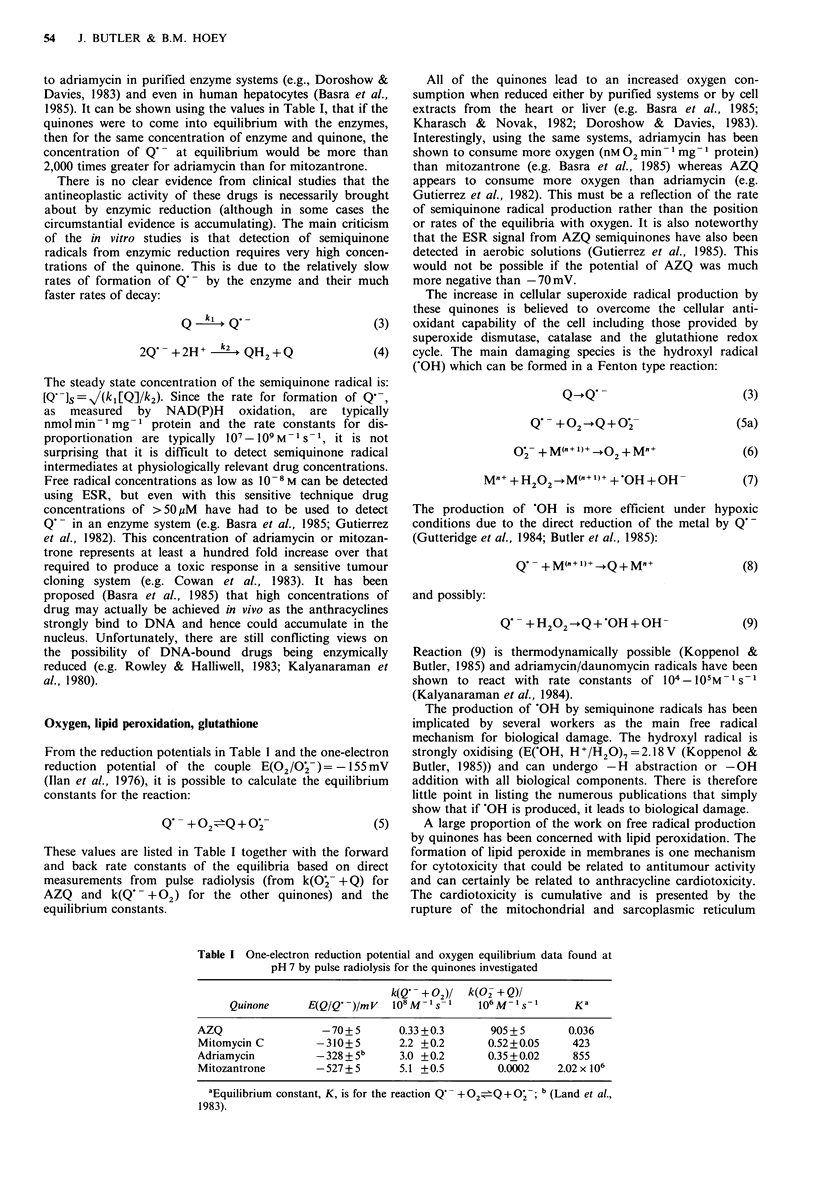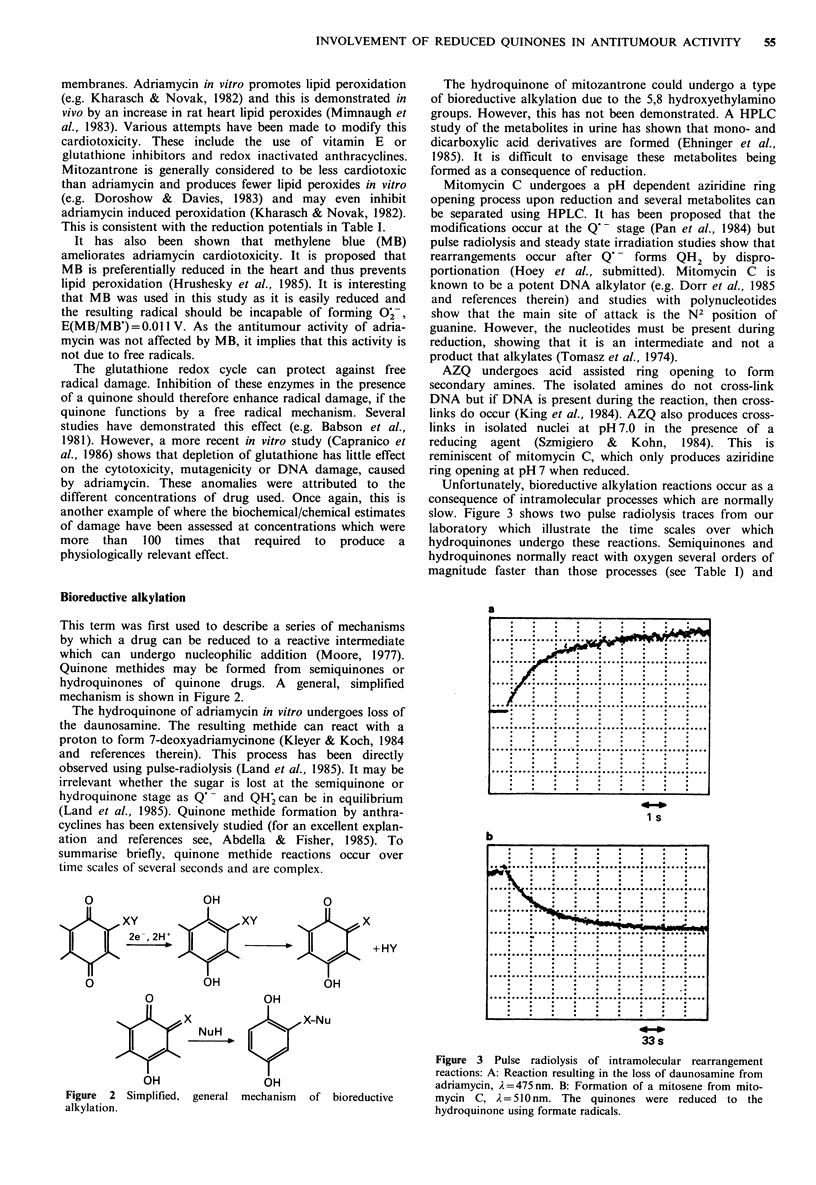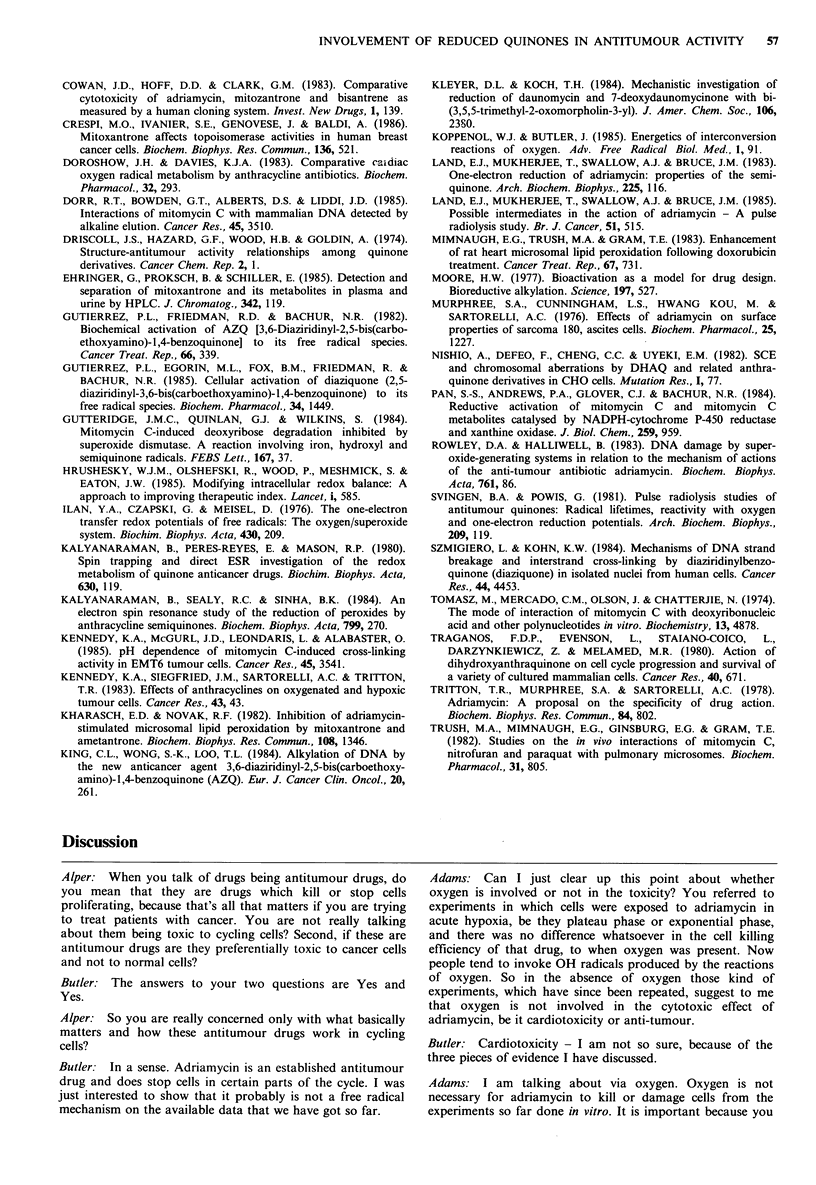Abstract
Several studies have shown that the antitumour quinones, adriamycin, mitomycin C, mitozantrone and 3,6-diaziridinyl-2,5-bis (carboethoxyamino)-1,4-benzoquinone (AZQ) can form semiquinone radicals in vitro. The biophysical chemistry data for these reactions and the properties of the radical quinones are presented together with the proposed mechanisms for cytotoxicity. An attempt has been made to correlate the available in vitro data for the quinones with each other and with the available in vivo data. As a consequence of these correlations a number of conclusions have been proposed regarding the techniques of investigation and the evidence for the role of reduced quinones in antitumour activity.
Full text
PDF




Selected References
These references are in PubMed. This may not be the complete list of references from this article.
- Babson J. R., Abell N. S., Reed D. J. Protective role of the glutathione redox cycle against adriamycin-mediated toxicity in isolated hepatocytes. Biochem Pharmacol. 1981 Aug 15;30(16):2299–2304. doi: 10.1016/0006-2952(81)90102-7. [DOI] [PubMed] [Google Scholar]
- Bachur N. R., Gee M. V., Friedman R. D. Nuclear catalyzed antibiotic free radical formation. Cancer Res. 1982 Mar;42(3):1078–1081. [PubMed] [Google Scholar]
- Basra J., Wolf C. R., Brown J. R., Patterson L. H. Evidence for human liver mediated free-radical formation by doxorubicin and mitozantrone. Anticancer Drug Des. 1985 Oct;1(1):45–52. [PubMed] [Google Scholar]
- Begleiter A., Grover J., Froese E., Goldenberg G. J. Membrane transport, sulfhydryl levels and DNA cross-linking in Chinese hamster ovary cell mutants sensitive and resistant to melphalan. Biochem Pharmacol. 1983 Jan 15;32(2):293–300. doi: 10.1016/0006-2952(83)90558-0. [DOI] [PubMed] [Google Scholar]
- Butler J., Hoey B. M., Swallow A. J. Reactions of the semiquinone free radicals of anti-tumour agents with oxygen and iron complexes. FEBS Lett. 1985 Mar 11;182(1):95–98. doi: 10.1016/0014-5793(85)81161-3. [DOI] [PubMed] [Google Scholar]
- Capranico G., Babudri N., Casciarri G., Dolzani L., Gambetta R. A., Longoni E., Pani B., Soranzo C., Zunino F. Lack of effect of glutathione depletion on cytotoxicity, mutagenicity and DNA damage produced by doxorubicin in cultured cells. Chem Biol Interact. 1986 Feb;57(2):189–201. doi: 10.1016/0009-2797(86)90037-2. [DOI] [PubMed] [Google Scholar]
- Cowan J. D., Von Hoff D. D., Clark G. M. Comparative cytotoxicity of adriamycin, mitoxantrone and bisantrene as measured by a human tumor cloning system. Invest New Drugs. 1983;1(2):139–144. doi: 10.1007/BF00172072. [DOI] [PubMed] [Google Scholar]
- Crespi M. D., Ivanier S. E., Genovese J., Baldi A. Mitoxantrone affects topoisomerase activities in human breast cancer cells. Biochem Biophys Res Commun. 1986 Apr 29;136(2):521–528. doi: 10.1016/0006-291x(86)90471-7. [DOI] [PubMed] [Google Scholar]
- Dorr R. T., Bowden G. T., Alberts D. S., Liddil J. D. Interactions of mitomycin C with mammalian DNA detected by alkaline elution. Cancer Res. 1985 Aug;45(8):3510–3516. [PubMed] [Google Scholar]
- Driscoll J. S., Hazard G. F., Jr, Wood H. B., Jr, Goldin A. Structure-antitumor activity relationships among quinone derivatives. Cancer Chemother Rep 2. 1974 Apr;4(2):1–362. [PubMed] [Google Scholar]
- Ehninger G., Proksch B., Schiller E. Detection and separation of mitoxantrone and its metabolites in plasma and urine by high-performance liquid chromatography. J Chromatogr. 1985 Jul 12;342(1):119–127. doi: 10.1016/s0378-4347(00)84494-1. [DOI] [PubMed] [Google Scholar]
- Gutierrez P. L., Egorin M. J., Fox B. M., Friedman R., Bachur N. R. Cellular activation of diaziquone [2,5-diaziridinyl-3,6-bis (carboethoxyamino)-1,4-benzoquinone] to its free radical species. Biochem Pharmacol. 1985 May 1;34(9):1449–1455. doi: 10.1016/0006-2952(85)90683-5. [DOI] [PubMed] [Google Scholar]
- Gutierrez P. L., Friedman R. D., Bachur N. R. Biochemical activation of AZQ [3,6-diaziridinyl-2,5-bis(carboethoxyamino)-1,4-benzoquinone] to its free radical species. Cancer Treat Rep. 1982 Feb;66(2):339–342. [PubMed] [Google Scholar]
- Gutteridge J. M., Quinlan G. J., Wilkins S. Mitomycin C-induced deoxyribose degradation inhibited by superoxide dismutase. A reaction involving iron, hydroxyl and semiquinone radicals. FEBS Lett. 1984 Feb 13;167(1):37–41. doi: 10.1016/0014-5793(84)80828-5. [DOI] [PubMed] [Google Scholar]
- Ilan Y. A., Czapski G., Meisel D. The one-electron transfer redox potentials of free radicals. I. The oxygen/superoxide system. Biochim Biophys Acta. 1976 May 14;430(2):209–224. doi: 10.1016/0005-2728(76)90080-3. [DOI] [PubMed] [Google Scholar]
- Kalyanaraman B., Perez-Reyes E., Mason R. P. Spin-trapping and direct electron spin resonance investigations of the redox metabolism of quinone anticancer drugs. Biochim Biophys Acta. 1980 Jun 5;630(1):119–130. doi: 10.1016/0304-4165(80)90142-7. [DOI] [PubMed] [Google Scholar]
- Kalyanaraman B., Sealy R. C., Sinha B. K. An electron spin resonance study of the reduction of peroxides by anthracycline semiquinones. Biochim Biophys Acta. 1984 Jun 29;799(3):270–275. doi: 10.1016/0304-4165(84)90270-8. [DOI] [PubMed] [Google Scholar]
- Kennedy K. A., McGurl J. D., Leondaridis L., Alabaster O. pH dependence of mitomycin C-induced cross-linking activity in EMT6 tumor cells. Cancer Res. 1985 Aug;45(8):3541–3547. [PubMed] [Google Scholar]
- Kharasch E. D., Novak R. F. Inhibition of adriamycin-stimulated microsomal lipid peroxidation by mitoxantrone and ametantrone, two new anthracenedione antineoplastic agents. Biochem Biophys Res Commun. 1982 Oct 15;108(3):1346–1352. doi: 10.1016/0006-291x(82)92148-9. [DOI] [PubMed] [Google Scholar]
- King C. L., Wong S. K., Loo T. L. Alkylation of DNA by the new anticancer agent 3,6-diaziridinyl-2,5-bis(carboethoxyamino)-1,4-benzoquinone (AZQ). Eur J Cancer Clin Oncol. 1984 Feb;20(2):261–264. doi: 10.1016/0277-5379(84)90193-7. [DOI] [PubMed] [Google Scholar]
- Land E. J., Mukherjee T., Swallow A. J., Bruce J. M. One-electron reduction of adriamycin: properties of the semiquinone. Arch Biochem Biophys. 1983 Aug;225(1):116–121. doi: 10.1016/0003-9861(83)90013-9. [DOI] [PubMed] [Google Scholar]
- Land E. J., Mukherjee T., Swallow A. J., Bruce J. M. Possible intermediates in the action of adriamycin--a pulse radiolysis study. Br J Cancer. 1985 Apr;51(4):515–523. doi: 10.1038/bjc.1985.74. [DOI] [PMC free article] [PubMed] [Google Scholar]
- Mimnaugh E. G., Trush M. A., Gram T. E. Enhancement of rat heart microsomal lipid peroxidation following doxorubicin treatment in vivo. Cancer Treat Rep. 1983 Jul-Aug;67(7-8):731–733. [PubMed] [Google Scholar]
- Moore H. W. Bioactivation as a model for drug design bioreductive alkylation. Science. 1977 Aug 5;197(4303):527–532. doi: 10.1126/science.877572. [DOI] [PubMed] [Google Scholar]
- Murphree S. A., Cunningham L. S., Hwang K. M., Sartorelli A. C. Effects of adriamycin on surface properties of sarcoma 180 ascites cells. Biochem Pharmacol. 1976 May 15;25(10):1227–1231. doi: 10.1016/0006-2952(76)90374-9. [DOI] [PubMed] [Google Scholar]
- Nishio A., DeFeo F., Cheng C. C., Uyeki E. M. Sister-chromatid exchange and chromosomal aberrations by DHAQ and related anthraquinone derivatives in Chinese hamster ovary cells. Mutat Res. 1982 Mar;101(1):77–86. doi: 10.1016/0165-1218(82)90167-7. [DOI] [PubMed] [Google Scholar]
- Pan S. S., Andrews P. A., Glover C. J., Bachur N. R. Reductive activation of mitomycin C and mitomycin C metabolites catalyzed by NADPH-cytochrome P-450 reductase and xanthine oxidase. J Biol Chem. 1984 Jan 25;259(2):959–966. [PubMed] [Google Scholar]
- Rowley D. A., Halliwell B. DNA damage by superoxide-generating systems in relation to the mechanism of action of the anti-tumour antibiotic adriamycin. Biochim Biophys Acta. 1983 Nov 22;761(1):86–93. doi: 10.1016/0304-4165(83)90365-3. [DOI] [PubMed] [Google Scholar]
- Svingen B. A., Powis G. Pulse radiolysis studies of antitumor quinones: radical lifetimes, reactivity with oxygen, and one-electron reduction potentials. Arch Biochem Biophys. 1981 Jun;209(1):119–126. doi: 10.1016/0003-9861(81)90263-0. [DOI] [PubMed] [Google Scholar]
- Szmigiero L., Kohn K. W. Mechanisms of DNA strand breakage and interstrand cross-linking by diaziridinylbenzoquinone (diaziquone) in isolated nuclei from human cells. Cancer Res. 1984 Oct;44(10):4453–4457. [PubMed] [Google Scholar]
- Tomasz M., Mercado C. M., Olson J., Chatterjie N. The mode of interaction of mitomycin C with deoxyribonucleic acid and other polynucleotides in vitro. Biochemistry. 1974 Nov 19;13(24):4878–4887. doi: 10.1021/bi00721a002. [DOI] [PubMed] [Google Scholar]
- Traganos F., Evenson D. P., Staiano-Coico L., Darzynkiewicz Z., Melamed M. R. Action of dihydroxyanthraquinone on cell cycle progression and survival of a variety of cultured mammalian cells. Cancer Res. 1980 Mar;40(3):671–681. [PubMed] [Google Scholar]
- Tritton T. R., Murphree S. A., Sartorelli A. C. Adriamycin: a proposal on the specificity of drug action. Biochem Biophys Res Commun. 1978 Oct 16;84(3):802–808. doi: 10.1016/0006-291x(78)90775-1. [DOI] [PubMed] [Google Scholar]
- Trush M. A., Mimnaugh E. G., Ginsburg E., Gram T. E. Studies on the in vitro interaction of mitomycin C, nitrofurantoin and paraquat with pulmonary microsomes. Stimulation of reactive oxygen-dependent lipid peroxidation. Biochem Pharmacol. 1982 Mar 1;31(5):805–814. doi: 10.1016/0006-2952(82)90467-1. [DOI] [PubMed] [Google Scholar]
- Tucker J., Ludlam C. A., Craig A., Philp I., Steel C. M., Tedder R. S., Cheingsong-Popov R., Macnicol M. F., McClelland D. B., Boulton F. E. HTLV-III infection associated with glandular-fever-like illness in a haemophiliac. Lancet. 1985 Mar 9;1(8428):585–585. doi: 10.1016/s0140-6736(85)91247-4. [DOI] [PubMed] [Google Scholar]


